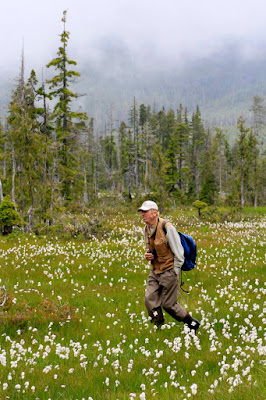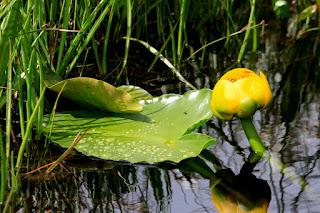These are some of my natural history ramblings, both literary and afoot, the result of a search for whatever there is to be found, including the native orchids and wildflowers of the beautiful state in which we live.
Thursday, July 28, 2011
Chiwaukum Creek
One of our favorite places for wildflowers is Chiwaukum Creek near Leavenworth and on June 10th, after visiting Derby Canyon and a place near Plain where we looked for Cypripedium fasciculatum, we spent some time hiking along the creek.
Driving into the campground at the trailhead we saw a Ruffed Grouse with her chicks. We watched her for a while calling to the chicks and were able to get pictures, but the chicks kept in the vegetation at the roadside and we were unable to get any pictures of them.
After parking the car we headed for a site near the trailhead where we knew the Western Fairy Slipper (Calypso bulbosa var. occidentalis) grew and found it everywhere in the woods, often in clumps of three or four plants, something we've not seen before.
In fact the Fairy Slippers were everywhere in the woods along the creek and among them we found one plant that appeared to be a semi-alba form with no coloring in the sepals and petals. That these flowers lose their color as they die may mean that we only found an older flower.
We also found some Morels which we took home and used in omelets the next morning, but the Mountain Roses (Lewisia tweedyi) were the real hit of the day. We found them in large clumps all along the trails often on inaccessible ledges and cliffs.
We photographed the Lewisia and all the other wildflowers we found including the wild Ginger and just meandered along the unused road and then the trail for several miles, enjoying the sunshine and the rushing creek and making no effort to hurry.
Some of the wildflowers we saw were Slender Woodland Star (Lithophragma tenellum), Harsh Paintbrush (Castilleja hispida), Arrowleaf Balsamroot (Balsamorhiza sagittata), Naked Broomrape (Orobanche uniflora), Long-tailed Ginger (Asarum caudatum), and Stream Violet (Viola glabella).
We returned to our car about 2:00 and headed home relaxed and happy after a great day's outing to this favorite place. We've gone before and we'll go again if we're able. The story of a previous hike at Chiwaukum Creek can be found here: http://ronaldhanko-orchidhunter.blogspot.com/2010/06/chiwaukum-creek.html.
Friday, July 22, 2011
Near Plain, Washington
After leaving Derby Canyon early in the morning on the 10th of June, we went on to the town of Plain, north of Leavenworth. We visited a site outside the town looking for the rare Clustered Lady's Slipper (Cypripedium fasciculatum), also known as the Brownie Lady's Slipper.
We quickly found a lot of the Western Spotted Coralroot (Corallorhiza maculata var. occidentalis) in the woods. They seem to be very abundant this year and this site was no exception. We searched everywhere for the Lady's Slipper, however, and in the end only found four plants.
We spent quite some time photographing them, not an easy task on the steep slopes where they grow and also took a few other pictures of the area and the wildflowers there before going on to our final hiking destination, Chiwaukum Creek, west of Leavenworth.
We had also been to the area about a month earlier and took a few pictures then as well, especially of the Oregon Anemones (Anemone oregana) in bloom. At that time we found some of the native orchids growing in the woods but not yet blooming.
Bog-trotting on Vancouver Island
On July 20, I traveled to Vancouver Island to meet a friend from New York and to go hunting with him for a very rare native orchid. He was in Vancouver in the middle of a native-orchid trek that had already covered 5000 miles. He had contacted Dr. Hans Roemer, a botanist and ecologist with the BC government who agreed to take us on a guided hike to see this orchid, Platanthera chorisiana, Chamisso's Orchid.
We had looked for this orchid in several locations here in Washington where it had been previously reported. We looked twice at Lake Serene and three or four times at Lake Elizabeth, both in the Central Cascades. At Lake Serene we discovered that the site had been destroyed by a rockslide, and at Lake Elizabeth could not find the plants which had been reported growing on a sedge mat on the far side of the lake.
The plant is actually quite small and insignificant - only about 15 cm with 3 mm flowers that do not open very far and are self-pollinating. We did find them in several different locations, about fifteen plants in all, but had to look hard for them as they were often hidden in other vegetation. Dr. Roemer had discovered them there years ago and had more recently obtained GPS coordinates for them.
Our excursion took us about two hours away from Victoria to the west and past the town of Sooke to a forest road that went up about 700 meters (2000 feet) above sea level to a very wet and boggy area, just the right conditions for this orchid which likes cold, high-altitude bogs. This day a cold mist was blowing in from the sea and that in combination with wading through the bog left us cold and wet.
We found the orchid immediately in the bog next to the place we parked, several plants growing on the north side of trees in somewhat shaded and slightly drier locations than the other plants. Growing all around were two other native orchids, the Slender Bog Orchis (Platanthera stricta) and the Bog Candle (Platanthera dilatata var. dilatata), along with numerous sedges and other bog plants.
There was evidence of bears everywhere, skunk cabbages dug up with their roots eaten and a lot of scat, some of it very fresh, but we saw no bears. We hiked in for about two hours, through open areas full of Cotton Grass and wildflowers, squelching our way through the bog and always watching for deeper holes. Tom, the friend from New York, actually did fall into one of the holes and got wet up to his knees.
We photographed a number of other wildflowers including the Columbia Lily (Lilium columbianum), the Swamp Gentian (Gentiana douglasiana), the Yellow Pond Lily (Nuphar polysepala), the Sticky False Asphodel (Tolfieldia glutinosa), an Aster that I did not ask about and have been unable to identify, and the ever-present Labrador Tea (Ledum groenlandicum).
At the location where Dr. Roemer had found Chamisso's Orchid previously we searched for quite some time and eventually found about a dozen plants. I am sure there were more, but they are so small and blend in so well with the surrounding plants, that we were fortunate to find so many. Ryan, a friend of Dr. Roemer, who accompanied us, seemed to be the best at finding them.
When we returned, we visited two other sites, a Provincial Park where Piperia elegans, the Elegant Piperia, was growing along the seaside. Many of the plants there were deformed, probably as the result of a late frost, according to Dr. Roemer. At his home we found that Piperia and another, Piperia transversa, the Flat-spurred Piperia, growing in the woods.
After enjoying the gracious hospitality of Dr. Roemer and his wonderful wife, Heidi, with coffee and tarts, we headed back to Victoria and parted ways, Tom to catch up with his family, and myself to catch the ferry for the mainland and home. It was a wonderful day, made all the more wonderful by Dr. Roemer's encyclopaedic knowledge of the flora, ecology and geology of Vancouver Island.
Subscribe to:
Comments (Atom)

















































